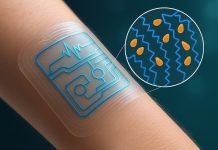
Imagine a future where your earbuds do everything your smartphone does, but better. Thanks to a breakthrough in materials science, this future could be closer than we think.
Researchers at the University of Arizona Wyant College of Optical Sciences and Sandia National Laboratories have made a significant advancement in a field known as phononics, which could lead to smaller, more powerful wireless devices.
Phononics is similar to photonics, but while photonics deals with photons (light particles), phononics involves phonons, which are particles that transmit mechanical vibrations similar to sound, but at frequencies too high for the human ear to detect.
These vibrations are key to new technologies that could revolutionize the way our devices operate.
In a study published in Nature Materials, the team demonstrated a new class of synthetic materials that allow phonons to interact in ways previously impossible.
This interaction is called “nonlinear phononics,” where phonons can change each other’s frequencies, much like how beams of light can change color under certain conditions.
This breakthrough could potentially shrink the physical size of devices such as smartphones and enhance their efficiency and power.
“Most people don’t know that their cell phone contains about 30 filters that convert radio waves into sound waves and back again, each time data is sent or received,” explained Matt Eichenfield, the senior author of the study.
These filters are part of what’s known as front-end processors. Because these filters can’t be made from common materials like silicon, they take up more space and lose some energy during conversion.
The new phononics materials could consolidate all these functions into a single chip, reducing the size of devices by as much as 100 times, according to Eichenfield.
The researchers have already created acoustic mixers and other components necessary for radio frequency signal processing using these new materials, indicating that they could soon produce an entire radio frequency front end on a single chip.
This accomplishment follows their previous success in developing acoustic components such as amplifiers and switches using similar materials.
The current breakthrough involved using a combination of semiconductor materials and piezoelectric materials in innovative ways.
For instance, they layered a thin film of indium gallium arsenide semiconductor onto a silicon wafer covered with lithium niobate, a material known for its piezoelectric properties but weak nonlinear characteristics when used alone.
By integrating these materials, the researchers enabled the acoustic waves to interact with the electrical charges in the semiconductor film.
This interaction enhances the nonlinearity of the phonons, allowing them to mix and change frequencies in a controlled manner—something that was previously challenging to achieve.
Lisa Hackett, the lead author of the paper, remarked on the significance of this new regime of phononic nonlinearity, suggesting that it could lead to the development of high-performance technology for sending and receiving radio waves in ways that are more compact than ever before.
With these developments, future communication devices could occupy virtually no space, provide better signal coverage, and have longer battery life.
This marks a significant step forward in the evolution of wireless technology, promising smaller, more efficient devices that could change the way we connect with the world.
Source: University of Arizona.



